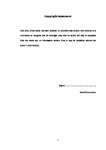DEVELOPMENT OF MINERAL PARTICLE SURFACES FOR THE ADSORPTION OF PITCH FROM WOOD PROCESSING AND RECYCLING OF PAPER
| dc.contributor.supervisor | Matthews Peter | |
| dc.contributor.author | Gantenbein , Daniel | |
| dc.contributor.other | School of Geography, Earth and Environmental Sciences | en_US |
| dc.date.accessioned | 2012-08-30T10:01:27Z | |
| dc.date.available | 2012-08-30T10:01:27Z | |
| dc.date.issued | 2012 | |
| dc.date.issued | 2012 | |
| dc.identifier | 10105137 | en_US |
| dc.identifier.uri | http://hdl.handle.net/10026.1/1175 | |
| dc.description | Full version unavailable due to 3rd party copyright restrictions. | |
| dc.description.abstract |
During the production of paper in paper mills, detrimental wood resin is released into the water circuit of the mill during the pulping process of the wood into fibres. This wood resin, termed pitch, can detrimentally deposit on the paper and on the paper machine equipment. The deposits mark the paper or can lead to a tear of the paper web involving a loss of output and a reduction in paper quality. Furthermore, the wood resinous compounds in paper mill effluents need to be reduced in order to minimise their toxic effects on water organisms. Talc has been the benchmark for many years as a mineral additive in pitch control. Since the papermaking process has changed over the years, the concept of mineral addition needs to be redefined and adopted towards the new circumstances. By understanding the fundamentals behind the adsorption of wood resin compounds from aqueous systems on to talc new mineral additives can be developed. A model for the determination of the aspect ratio of platy and rod-like particles has been developed, based on commonly available characterisations such as particle size, specific surface area and shape. It was found that the adsorption capacity of a mineral is directly proportional to its specific surface area, but only within its mineral family. Including the effect of surface hydrophilicity and hydrophobicity allowed fine tuning of the adsorption capacity of newly developed calcium carbonate grades. Furthermore, size exclusion effects, in porous, high surface area modified calcium carbonate, were seen to hinder complete coverage of the surface area by wood resin. With increasing pH, the adsorption efficiency of talc for colloidal wood resin was found to decrease. Under these alkaline conditions, which are common in modern paper making processes, talc preferentially adsorbed dissolved species. The use of the newly developed surface treated and modified calcium carbonates allowed more efficient adsorption of the colloidal fraction and, therefore, represent an efficient alternative to talc in pitch control. An increase in temperature led to an increased adsorption capacity of talc. This observation indicates the type of interaction tat controls the adsorption of hydrophobic pitch particles onto talc, i.e. the entropically favoured release of water from the hydrophobic talc surface as well as the hydrophobic methylene backbone of the hemicellulose. | en_US |
| dc.description.sponsorship | Omya Development AG | en_US |
| dc.language.iso | en | en_US |
| dc.publisher | University of Plymouth | en_US |
| dc.subject | Pitch | en_US |
| dc.subject | Wood resin | en_US |
| dc.subject | Talc | en_US |
| dc.subject | Calcium Carbonate | en_US |
| dc.subject | Adsorption | en_US |
| dc.subject | Aspect ratio | en_US |
| dc.subject | Dissolved and colloidal substances | en_US |
| dc.subject | Paper making | en_US |
| dc.subject | Detackification | en_US |
| dc.title | DEVELOPMENT OF MINERAL PARTICLE SURFACES FOR THE ADSORPTION OF PITCH FROM WOOD PROCESSING AND RECYCLING OF PAPER | en_US |
| dc.type | Thesis | |
| plymouth.version | Edited version | en_US |
| dc.identifier.doi | http://dx.doi.org/10.24382/1431 |
Files in this item
This item appears in the following Collection(s)
-
01 Research Theses Main Collection
Research Theses Main


